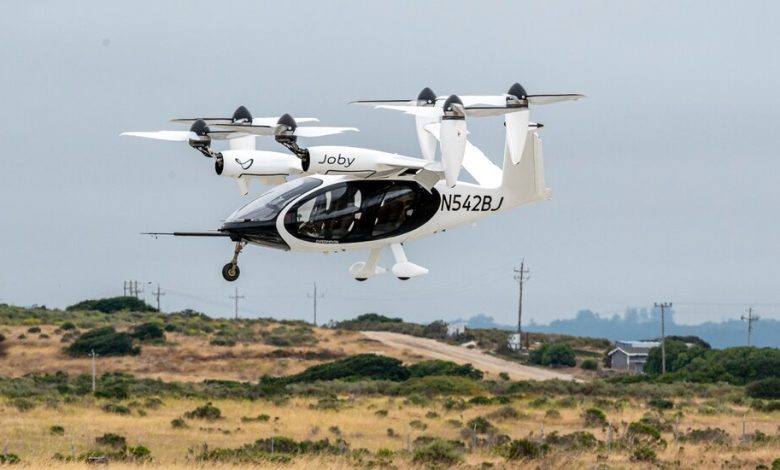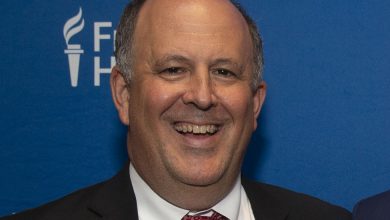Air Taxis, Hyped for Years, May Finally Take Off

For years, flying taxis have represented an exciting but distant dream, fueled in part by industry hype. Now they have a rollout plan and a target arrival date: 2028.
In a document published on Tuesday, the Federal Aviation Administration outlined the steps that it and others need to take to usher in a competitive air taxi market in at least one location by 2028 with limited operations starting as early as 2025. The vehicles look like small airplanes or helicopters and can take off and land vertically, allowing them to operate from the middle of cities, whisking people to airports or vacation destinations like the Hamptons in New York or Cape Cod in Massachusetts.
The F.A.A.’s plan is notable because it reflects confidence that the technology is only a few years away, and because it comes from the agency that will oversee certification of the aircraft as well as the rules that pilots and companies must follow.
“These things will be coming on the scene, and our job is to try and be ahead of the curve,” said Paul Fontaine, an assistant F.A.A. administrator who oversees the modernization of the air transportation system. The plan is intended to serve as a guide for introducing the aircraft in a way that is predictable and routine, the agency said.
Creating the conditions for air taxis to zip above one or more cities by 2028 will be no small task, and aircraft manufacturers will need the help of many others besides the F.A.A., including other federal agencies and state and local governments.
Air taxis are likely to face resistance from local officials and residents who fear that they will be safety hazards or a nuisance. Legislation and lawsuits seeking to block their use in cities and neighborhoods could set up pitched battles.
But first the aircraft must be certified. Many are designed to be fully electric, though some could be powered by hydrogen or a combination of jet fuels and batteries. The aircraft are still under development by various companies and can carry only a handful of passengers. They also contain an array of new technologies and systems, many of which will have to be individually certified to meet the F.A.A.’s standards.
“With a lot of new aircraft technology, you bring on one very novel thing and you work your way through that,” said Pat Anderson, a professor at Embry-Riddle Aeronautical University and a co-founder of VerdeGo Aero, a hybrid air taxi company. “In these vehicles, we’re trying to bring many, many things forward, all at once.”
Joby Aviation and Archer Aviation are among the U.S. air taxi companies furthest along in that certification process, and both hope to have certified aircraft and start commercial services in 2025, ahead of the F.A.A.’s 2028 goal. To achieve their targets, they will have to win the approval of the federal agency and local officials for specific services and routes.
But air taxi companies have had to delay such plans in the past. In 2017, Uber said it was working on electric air taxis that would conduct passenger flights by 2020. Instead, that was the year Uber sold its air taxi unit to Joby, which said at the time that service could begin “as early as 2023.”
Even traditional airplanes made by manufacturers with decades of experience, such as Boeing and Airbus, often face long certification delays. And F.A.A. officials said they would not compromise safety to meet the 2028 target.
Limits on battery capacity mean the distance that many air taxis can fly will be restricted. As a result, the aircraft will probably first be used to transport people in cities to nearby airports — a service that some companies already offer with helicopters in cities like New York.
Air taxi companies will have to compete for scarce real estate, navigate city and state regulations, develop the infrastructure to charge or fuel aircraft, and gain acceptance from residents. They will also have to hire and train pilots, who are in high demand.
Still, the F.A.A.’s plan underscores a growing belief among industry analysts and executives that the necessary elements are coming together for air taxis to take off.
“People always ask me, ‘Why is this happening now?’” said Adam Goldstein, the chief executive of Archer. “It’s the tech, the regulation and the money that allowed us get here.”
The F.A.A. has been criticized for moving too slowly on certifying air taxis and other novel aircraft. In a June report, the Transportation Department’s inspector general concluded that poor communication internally and externally could increase “the risk of certification and operational delays.”
But the agency has been making some progress, recently updating a technical road map for rolling out air taxis in cities and publishing a proposed rule in June governing how air taxi pilots should be trained and certified.
Air taxi manufacturers have made technological strides, too, with several now regularly test-flying their aircraft.
Investors have taken notice. Several major air taxi companies have gone public in recent years, including Joby, Archer, Lilium in Germany and Vertical Aerospace in England. This year, Archer, Joby and Lilium raised more than $150 million each from investors.
Many of the companies have also deepened ties with major airlines or automakers. Stellantis, the automaker that owns Jeep, Peugeot and other brands, is helping to build a factory in Georgia for Archer, which has a tentative agreement to sell several hundred aircraft to United Airlines and Mesa Airlines. Joby has a close relationship with Toyota.
Boeing recently bought Wisk, which is working on an autonomous air taxi. And Embraer, a Brazilian company that makes smaller commercial planes, created its own air taxi company, Eve Air Mobility.
The businesses are all vying for a market that could someday be worth tens of billions of dollars. The aircraft might replace some trips that take place through Uber and Lyft. For airlines, air taxis could help them win over or maintain the loyalty of affluent passengers.
There are other opportunities, too. UPS is working with the air taxi maker Beta Technologies to test air taxis for cargo in the United Arab Emirates. Beta and Joby have also worked with the U.S. military.
The key to winning over the public will be making air taxis cheap enough that many people can use them, said Michael Huerta, a former F.A.A. administrator, who is now a director on the boards of Delta Air Lines and Joby.
“Over time, it will get larger public acceptance, but critical to that is going to be cost,” he said. “If you see this only as a service for very wealthy people, and you’re dealing with the impacts of it, you might be less accepting.”





